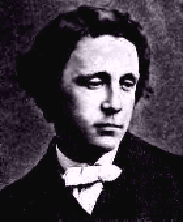|
|
|
Lewis Carroll
| Lewis Carroll, Pseudonym of Charles Lutwidge Dodgson (1832-98), English author, mathematician, and logician, best known for his creation of the immortal fantasy Alice in Wonderland. |  |
Carroll was born in Daresbury, Cheshire, on Jan. 27, 1832, and was educated at rugby and at Christ Church College, University of Oxford. From 1855 to 1881 he was a member of the faculty of mathematics at Oxford. He was the author of several mathematical treatises, including Euclid and His Modern Rivals (1879). In 1865 he published under his pseudonym Alice's Adventures in Wonderland. Its sequel, Through the Looking-Glass and what Alice Found There, Appeared in 1872. These were followed by Phantasmagoria and Other Poems (1869), The Hunting of the Snark (1876), and a novel, Sylvie and Bruno (2 vol., 1889-93). He died at Guildford, Surrey, on Jan 14, 1898.
Always a friend of children, particularly little girls, Carroll wrote thousands of letters to them, delightful flights of fantasy, many illustrated with little sketches. They have been collected and published as The Letters of Lewis Carroll (2 vol., 1979) by Morton N. Cohen and Roger L. Green. Carroll gained an additional measure of fame as an amateur photographer. The greater number of his camera portraits were of children in various costumes and poses, including nude studies; he also did portraits of adults, including the actress Ellen Terry and the poets Alfred Lord Tennyson and Dante Gabriel Rossetti. Apparently because his posing of children was criticized, he abandoned photography in 1880.
The Alice stories, which have made the name Lewis Carroll famous throughout the world, and have been translated into many languages, were originally written in 1862 for Alice Liddell (d. 1934), a daughter of Henry George Liddell (1811-98), dean of Christ Church College. On publication, the works, illustrated by the English Cartoonist Sir John Tenniel, became immediately popular as books for children. Their subsequent appeal to adults is based upon the ingenious mixture of fantasy and realism, gentle satire, absurdity, and logic. The names and sayings of the characters, such as the March Hare, the Mad Hatter, the Cheshire Cat, and the White Knight, have become part of everyday speech.
Source: Funk and Wagnalls New Encyclopedia